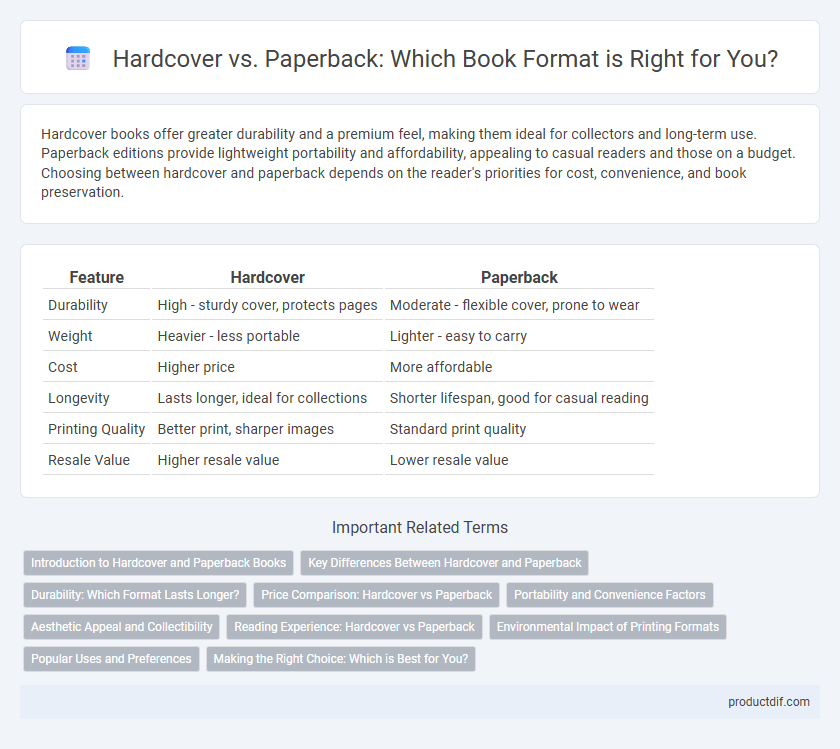Hardcover books offer greater durability and a premium feel, making them ideal for collectors and long-term use. Paperback editions provide lightweight portability and affordability, appealing to casual readers and those on a budget. Choosing between hardcover and paperback depends on the reader's priorities for cost, convenience, and book preservation.
Table of Comparison
| Feature | Hardcover | Paperback |
|---|---|---|
| Durability | High - sturdy cover, protects pages | Moderate - flexible cover, prone to wear |
| Weight | Heavier - less portable | Lighter - easy to carry |
| Cost | Higher price | More affordable |
| Longevity | Lasts longer, ideal for collections | Shorter lifespan, good for casual reading |
| Printing Quality | Better print, sharper images | Standard print quality |
| Resale Value | Higher resale value | Lower resale value |
Introduction to Hardcover and Paperback Books
Hardcover books feature rigid, protective covers made from cardboard or heavy paperboard wrapped in cloth or leather, providing durability and longevity. Paperback books have flexible, lightweight covers made from thick paper or cardstock, making them more affordable and portable. Both formats cater to different reader preferences, with hardcovers often favored for first editions and collectors, while paperbacks are popular for casual reading and mass-market distribution.
Key Differences Between Hardcover and Paperback
Hardcover books feature rigid protective covers made of cardboard covered with cloth or leather, offering greater durability and a premium feel, while paperbacks have flexible, lightweight covers made of thick paper or cardstock, making them more affordable and portable. Hardcover editions typically include higher-quality paper and design elements, contributing to a longer lifespan, whereas paperbacks prioritize convenience and cost-effectiveness for mass-market distribution. The pricing difference is significant, with hardcovers generally priced higher due to production costs and perceived collector value, whereas paperbacks target budget-conscious readers seeking accessibility.
Durability: Which Format Lasts Longer?
Hardcover books feature a rigid protective cover made from cardboard wrapped in cloth or leather, significantly enhancing their durability compared to paperback editions with flexible, thin paper covers prone to bending and tearing. The sturdy construction of hardcovers withstands frequent handling, environmental damage, and shelf wear, making them a preferred choice for archival purposes and long-term collections. Paperbacks, while lightweight and portable, typically show signs of wear more quickly due to their less robust binding and cover materials.
Price Comparison: Hardcover vs Paperback
Hardcover books generally cost significantly more than paperbacks due to higher production expenses, including sturdy binding materials and durable covers. Paperback editions offer a more affordable alternative, making them popular for budget-conscious readers and mass-market distribution. Pricing differences also reflect factors like anticipated readership, with hardcovers often released first to maximize revenue from avid fans.
Portability and Convenience Factors
Hardcover books, with their rigid covers and heavier weight, often sacrifice portability compared to lightweight and flexible paperback editions, which easily fit into bags and backpacks for on-the-go reading. Paperbacks offer greater convenience for travel and commuting due to their compact size and lower cost, making them ideal for casual readers seeking ease of use. However, hardcovers provide durability and protection, advantageous for long-term collection but less practical for frequent transport.
Aesthetic Appeal and Collectibility
Hardcover books boast a sturdy, elegant appearance with embossed covers and high-quality dust jackets, making them highly desirable for collectors seeking long-lasting, visually appealing editions. Paperbacks offer flexibility and affordability but often lack the durability and refined craftsmanship that contribute to a book's aesthetic value and collectible status. The limited print runs and unique features of hardcovers typically increase their rarity and worth in the collectors' market.
Reading Experience: Hardcover vs Paperback
Hardcover books offer a sturdy, durable construction that enhances the reading experience with a solid feel and easy page-turning, making them ideal for collectors and frequent readers. Paperback books provide a lightweight, flexible format that is portable and comfortable for extended reading sessions, especially on the go. Both formats influence reading comfort differently, with hardcover emphasizing longevity and paperbacks prioritizing convenience.
Environmental Impact of Printing Formats
Hardcover books generally have a higher environmental impact due to their use of more materials such as cardboard, cloth, and heavier inks, resulting in increased resource consumption and energy use during manufacturing. Paperback books use less material overall and are lighter, which reduces transportation emissions and raw material extraction. Both formats can be sustainable when printed on recycled or FSC-certified paper and with eco-friendly inks.
Popular Uses and Preferences
Hardcover books are preferred for collectible editions and gifts due to their durable construction and premium appearance, making them popular among avid readers and libraries. Paperback books dominate casual reading markets and educational settings because they are lightweight, affordable, and portable. Market trends indicate a steady demand for paperbacks among young adults and students, while hardcovers maintain appeal for first editions and special releases.
Making the Right Choice: Which is Best for You?
Choosing between hardcover and paperback formats depends on durability, cost, and reading preferences. Hardcover books offer long-lasting protection and a premium feel, ideal for collectors or frequent readers who value book preservation. Paperbacks provide affordability and portability, making them suitable for casual reading and travel convenience.
Hardcover vs Paperback Infographic

 productdif.com
productdif.com